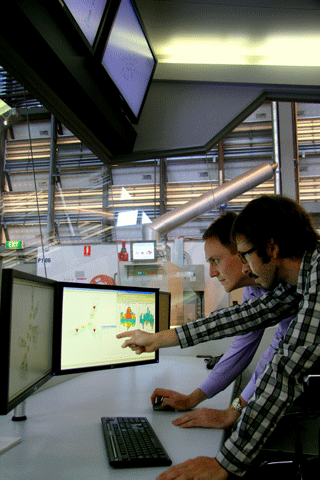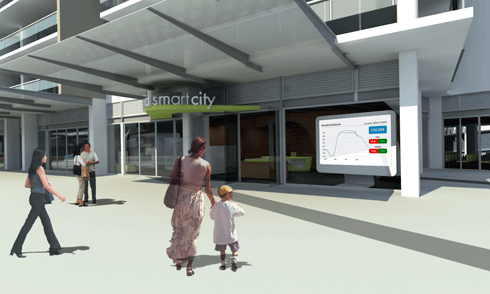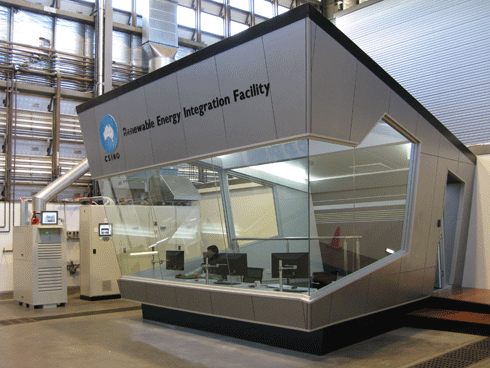
|
Published: 4 July 2011
Smartening up the grid
Experts are calling for an energy sector makeover – a ‘smart’ upgrade of our ageing electricity grid to create a network that can better respond to changing supply and demand, and bring our electricity system securely into the future. It will require an integrated response involving researchers, industry, government and consumers.

|
|
Researchers at CSIRO’s Renewable Energy Integration Facility are investigating how to best integrate renewable energy into the electricity grid. Credit: CSIRO
|
Dr Lilley is involved in CSIRO’s Future Grid project, which is developing a modelling framework that will help determine the most efficient and least-cost design of the grid. The framework is due to be finalised in the next one to two years.
‘The project aims to deliver economic modelling, power systems modelling and social analysis, to ensure that we make the most out of our centralised and decentralised assets,’ explains Dr Lilley. ‘Within this, smart grid technology is an enabling technology to both make the grid more efficient, and allow the integration of existing and new technologies, including renewable generators.’
Smart grids don’t necessarily require a reinvention of the wheel. Dr David Cornforth, is Project Leader at CSIRO’s Renewable Energy Integration Facility (REIF) at the CSIRO Energy Centre in Newcastle, New South Wales. He there is a lot of potential to apply new and existing technologies to the current electricity grid. These are not necessarily quick fix solutions, he adds: the development of smarter grids is likely to continue over the next 20 years.
Smart Grid Smart Cities
What will the smart grid look like? Dr Glenn Platt, CSIRO’s Energy Technology Research Group Leader, says families will see the change through increased information, enabling them to ‘understand and make much more informed decisions on energy use’.
Behind the scenes, however, significant changes to electricity infrastructure are already occurring. To determine how a smart grid might work in practice, the federal government initiated Smart Grid Smart Cities (SGSC), a commercial?scale project being rolled out across five sites in Sydney and the Hunter Valley, New South Wales. With $100 million in federal funding, the project is being led by Ausgrid, a NSW-government owned energy infrastructure maintenance company, and involves a consortium of businesses ranging from IBM Australia to Newcastle City Council.
SGSC is not the only smart grid trial happening in Australia. But, as Mr Popple explains, this particular trial is important because it is a commercial?scale ‘community trial’, which will investigate regulatory and consumer uptake factors, as well as new technology solutions.
CSIRO has been heavily involved in the development phase of the trial. Dr Platt explains that while the organisation’s exact role in the next stage rollout is still being determined, it is likely to involve new control techniques that sit on top of the smart grid infrastructure Ausgrid is implementing, to deliver ‘even greater benefits’.
The breadth of CSIRO’s research into more intelligent energy systems reflects both the complexity and scale of these systems, as well as the recognised potential to develop least-cost smart grids, and more generally, a smarter electricity system.
Integrating renewables
The increase in renewable energy being fed into the network is one factor currently causing problems for network providers. In response, Dr Cornforth’s team at the REIF is researching the challenge of how to best couple the intermittence or variability of renewable energy into the grid without disturbing the ‘finely balanced’ grid system.
The team is looking at three main techniques in response to problems caused by power surges through the grid from renewable generation. These are: mixing intermittent renewable energy sources, such as solar photovoltaics, with more controllable sources, such as gas; different types of energy storage; and load control, which involves controlling the consumption of electricity.
‘It’s difficult to say what mix of these three [techniques] we will have, but it’s almost certain that all three will be part of the future solution – part of the smart grid of the future,’ says Dr Cornforth.
To facilitate wide research, the REIF is connected to solar photovoltaics, wind turbines, natural gas?powered combined heat and power cogeneration units, a load bank, inverters and three different types of battery storage. In relation to storage, the facility is looking at ‘how’ and ‘when’ questions. These include how to determine the ideal amount of renewable energy for the network given the additional cost of battery storage, and how to control that storage in terms of the best time to charge or discharge batteries.
Smarter control
Dr Cornforth explains that the traditional view of electricity supply and demand is shaped by non-renewable, baseload power generation and matches supply to meet demand, allowing people to consume as much power as they want, whenever they want. ‘Load control contemplates an alternative view, where consumption of power is controlled to meet available supply.’ ‘This view says: “You’ve got this much electricity because of what’s happening with the weather. Let’s now plan our consumption to match what we’ve got being generated during this time”.’

|
|
An artist’s impression of the Smart Grid Smart City information centre at Newcastle, the site of Australia’s first commercial-scale smart grid. Credit: Courtesy of Ausgrid
|
The Energy Technology group is developing smarter energy control systems to better manage energy without affecting people’s lifestyle within a building or home. Dr Platt’s group was responsible for developing a product called Building IQ, now commercialised, which reduces energy consumption in large office buildings based on human comfort considerations. He describes the technology as ‘adding brains to an office building’s air conditioner’ to control the building’s climate, while also factoring in electricity tariffs and carbon dioxide emissions.
Electric vehicles
Electric vehicles present significant opportunities for society; they decrease our reliance on fossil fuels, and when powered with clean energy, also decrease carbon dioxide emissions. For networks, however, they are both a potential solution and problematic. A major project under Dr Platt’s leadership, tentatively dubbed the Electric Driveways project, is one of the largest electric vehicle trials in the southern hemisphere. Working with the Victorian Government, the project is collecting data on how people use electric vehicles, to improve predictions of their uptake in Australia and help forecast the effect of electric cars on the grid.
The Electric Driveways project is also researching the control of electric vehicle battery charging and discharging to benefit the grid. Dr Platt says smart control systems are fundamental to this beneficial integration. Currently in its initial stages, CSIRO’s work aims to combine information on energy consumption, generation and pricing to determine the best times of day to charge or discharge a vehicle’s battery.
Barriers to implementation
So while developing smarter grids poses a number of challenges, Dr Cornforth thinks the evolving research on solutions, discussed above, is probably just the start of CSIRO’s work in intelligent energy systems. He believes that encouraging collaboration between people from different disciplines is key to further developing successful technical outcomes.
In this sense, Mr Popple of Smart Grid Australia says that the SGSC commercial-scale community smart grid trial is important, because it will implement scenarios in the real world, allowing them to be commercially evaluated. ‘We can ask, for example, whether in fact a business acting in a normal commercial framework would make an investment decision [into smart grid infrastructure engagement], and if not, what changes might have to occur [to effect it],’ he explains.
Dr Lilley says that the SGSC trial will also give policy makers better understanding of the value of smart grid technologies and techniques. ‘This will help them develop mechanisms to overcome existing issues, such as split incentives1 and information barriers, to ensure smart grids reach their full potential.’
‘By better understanding the value of smart grids, information barriers can be reduced, ensuring that investment in a smarter and more efficient grid can be measured and quantified. This helps ensure investors in the market receive adequate reward for the benefit they provide,’ Dr Lilley explains.
Fundamentally, however, consumer engagement and education about grid changes are essential. ‘There is some really great engineering going on, but we have to keep in mind the end-user,’ says Dr Platt. ‘If we’re not considering, for example, whether or not they will be happy with us adjusting their air conditioning, or what the benefits are to them of us spending large amounts of money on electricity infrastructure, then I think we’ll have some fairly major problems.’
Dr Cornforth explains that ‘The kinds of complicated decision-making processes involved in smart grids requires the collection of a lot more information from electricity users.’ However, Smart Grid Australia has identified that resolving concerns about privacy and security of data is vital to promoting consumer acceptance of smart grid technology.
‘Consumer engagement should be the first step to rolling out smart grid technology, and it probably hasn’t been researched very well anywhere in the world’, says the alliance’s Chairman, Mr Popple. ‘The ultimate aim is to get to the point where consumers understand the benefits sufficiently so that they will be demanding these smart grid alternatives as the way of the future.’
More information
Smart Grid Australia:
www.smartgridaustralia.com.au
CSIRO Energy Technology:
www.csiro.au/org/ET.html
CSIRO SGSC: www.csiro.au/partnerships/Smart-grid-smart-city.html
CSIRO Intelligent Energy:
www.csiro.au/science/Intelligent-Energy.html
CSIRO Renewable Energy Integration Facility: www.csiro.au/places/Renewable-Energy-Integration-Facility.html
1 Split incentives – where an action or investment is performed by one person or party, and the benefits are enjoyed by others – are a barrier to the implementation of smart grids.




